With the proliferation of Metroidvania action-platformers and now Soulsvanias of the same breed, it seems to take a little more to attract those interested in the niche that’s been carved out. What drove players toward Game Kitchen’s BLASPHEMOUS was the combination of a punishing hack-n-slash experience with brutally gothic themes, presented in a gorgeous pixelated art style. Screenshots highlight the protagonist’s bizarrely conical helmet and penchant for visceral executions of the macabre characters that inhabit this strange world. Obviously, an experience this grotesque combined with the possibility of highly-skilled speedruns would draw a crowd, and it has.
But as someone whose greatest effort on the site was a three-part exploration of a game heavily steeped in Catholic dogma and mythos, I couldn’t help but scrutinize the intensely religious themes in BLASPHEMOUS. It’s not as if they’re incredibly subtle, just look at the name. As I played through I began to wonder if exploring these themes and subjects would help fill in the narrative of this world a little bit. Like the Dark Souls series (well, like most of From Software’s lineup, but I don’t know if I can get SekiSoulsBorne to catch on), the backstory surrounding the world of BLASPHEMOUS and how it seems to have found itself in the grips of a surreal cataclysm is told through the descriptions and flavor text of the various baubles and trinkets the protagonist, known in-game as simply The Penitent One, picks up on the course of his penance, which apparently is to slaughter various beasts that have been created from The Great Miracle.
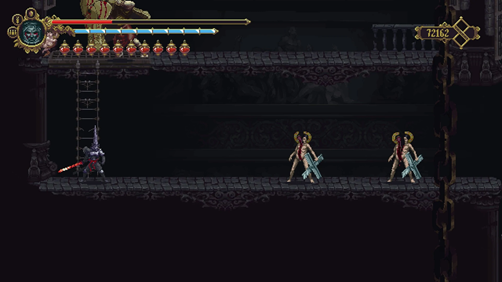
The Penitent One is canonically mute, and one theory posits that it’s because of a joke directed towards these guys about a “splitting headache”
The game doesn’t offer a lot of context as to what The Great Miracle is, or what exactly brought it to the land of Cvstodia, but there are a couple of creation myths, both involving guilt-ridden or otherwise despairing holy men transfigured into trees through sheer force of guilt. It’s implied that there was a time where it wasn’t as active or vindictive, or possibly wasn’t even in the world at all. Either way, it seems to be The Penitent One’s charge to slay the monstrosities that have arisen because of The Miracle, and either save the world or simply reset it to a less cruel state. There’s more than one ending the player can get, but only one of which is the “true” ending, and it seems like things end up better in the true ending.
As in games like DARK SOULS, the primary loop consists of making one’s way through the harsh game world, occasionally solving puzzles, and engaging in frantic boss battles. Players will find themselves making the same run over and over, dying on the same obstacle, only to overcome and then die again when a new one presents itself. In the spiritual context of BLASPHEMOUS, this takes on another meaning; properly praying the Catholic Rosary consists of the same prayers repeated over and over for each specific bead or point on the rosary. It’s often used to entreaty God’s favor, thank God for something, or simply as a daily meditative prayer. Oftentimes, it’s performed by Catholics at the behest of a priest as a form of penance during the sacrament of Reconciliation. Much in the same way that this penance asks a sort of sacrificial repetition, progressing through the particularly difficult parts of BLASPHEMOUS comes out the same way. Just as by the end of the prayer you’ll know your Hail Marys in your sleep, by the time you reach the end of a particular area you may have memorized the tactics and tricks of your enemies, and will reflexively fire off the button combinations needed to beat them.
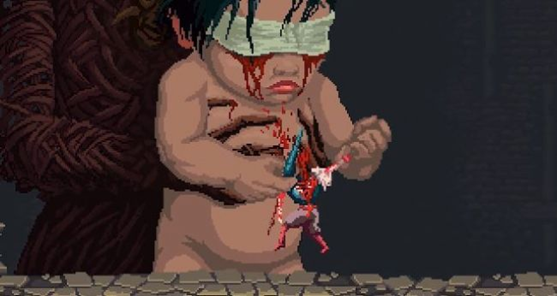
Also because you’ll have said “Oh Jesus Christ” quite a bit by the end of it
There are other mechanics in the game that take cues from Christian and Catholic dogma and iconography, at least superficially. The Penitent One carries a rosary which can be adorned with various objects found throughout the game. While real life prayer beads are used to track the number of Hail Marys uttered, the baubles in BLASPHEMOUS confer boons such as resistance to poison, because this is Extreme Catholicism. The player can also cast spells in the form of different prayers, depending on if they have enough fervor to do so. Fervor is gained by killing enemies, but the max amount will decrease after every death unless the player finds their corpse and picks up the “guilt fragment” left behind or prays to a Confessor statue. This is meant to represent each death of the Penitent One as a failure of penance, and the guilt is left behind as a physical manifestation.
The player also collects relics to give them certain advantages or unlock special areas, many of which take the form of preserved organs or items of clothing. While the Christian tradition certainly doesn’t have a monopoly on the idea of sacred objects, it is no less a historically common happenstance. Things like preserved organs and items of clothing were all hoarded by churches trying to win at holiness, and even bones would be stockpiled. BLASPHEMOUS incorporates this by including bones of various denizens of Cvstodia for the player to collect in an ossuary. Each name connected to the bone is the name of someone who donated a certain amount to the game’s initial Kickstarter, and completing the task results in an achievement as well as an additional skin. Again, while preserving the limbs and extremities of holy men and women is by no means a purely Catholic tradition, it’s still an obsessive hallmark of the religion, going so far as to even spark conflict between churches over who truly had the discarded foreskin of Christ. These sorts of additions and mechanics make interesting window dressing for the rest of the game, and provide paragraphs of additional lore surrounding the land of Cvstodia and those that once lived there.

This is Altasgracias and this is what happens when you and your sisters break off an engagement
The Penitent One’s unrelenting assault on the creatures of Cvstodia seems to come off as a critique of the Catholic Church, but never really amounts to much more than “I’ll go to Confirmation classes because my mom wants me to but I refuse to learn anything,” a mindset that I can very much relate to. Again, it’s not entirely clear what TPO is fighting against, other than the dominant form of the religion itself. Eventually you have to kill the pope, which seems like a clear indication of dissatisfaction with the religion itself, but there’s no real indication as to the tenets of this religion, other than penance is exalted. So there’s no real ideal TPO is fighting for other than “What if people didn’t feel the need to do horrible shit to themselves or feel like they deserved the horrible shit that happens to them?” which is an admirable goal and a concept many would probably agree with.
But it’s not just Catholicism the game is presenting, it is very specifically Spanish Catholicism, as Game Kitchen is based in Seville, Spain. This context furthers the earnestness of viewing suffering as a way to alleviate guilt or to increase holiness that makes up much of the basis of Catholic dogma. The phrase “original sin” or “sins of the father” is a primarily Catholic notion that posits that all humans are inherently sinful or born with sin after the events of the Garden of Eden. As I came to see it, basically anytime you’re made physically uncomfortable is an opportunity to reflect on how you probably deserve it. Thus every character the player encounters in BLASPHEMOUS has this “It is what it is” view to their lot in life. The developers also explain that many local legends found their way into the game in one way or another.
I spoke to Fernando Amador, a classmate of mine who wrote his B.A. Thesis on early modern Spain, if he had any insight on the prevalence of Catholic Mysticism in Spain. He explained that the Golden Age of Spain was a time of high art and literature, and as authors delved into surreal and fantastic themes, it tended to seep into the public consciousness surrounding the Catholic Church. The Golden Age of Spain, coincidentally, lines up with the height of the Spanish Inquisition. This confluence of themes reinforces what makes the world and creatures of BLASPHEMOUS such a distinct creation of the developers, literally a product of their environment.
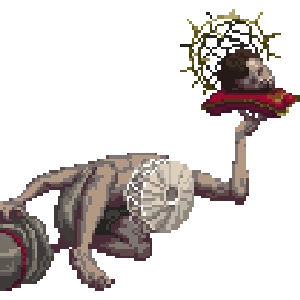
“Ehhh, it’s a living!”
The lore of BLASHPEMOUS describes the player enemies coming into the world full of “great faith and great rage.” The zealous nature of these villains seems to reflect the zealotry of the Spanish Inquisition, whose headquarters were largely in Seville. The Inquisition, for those who didn’t expect it in this article, was a time where the religious leaders of Spain (which also happend to be the actual rulers of Spain) were obsessed with religious orthodoxy, and made a point to force their Jewish populations to either convert or be cast out, along with their Muslim populations. King Phillip II of Spain, for example, saw himself as the Champion of Christianity. According to the BLASPHEMOUS Kickstarter page, the land of Cvstodia was initially Ortodoxia, which feeds into the game’s narrative of a land corrupted by a somewhat vengeful, divine force, almost bordering on cosmic horror. There are instances in the game’s lore where the onslaught of psychopathic zealots is a sign of their holiness, and truly the game’s name derives from TPO’s desire to snuff them out.

I am required by law to insert this picture after that reference
The game and even the developers’ connection to the Spanish Inquisition shows up in several other aspects of the game, particularly in the character designs. The Penitent One, for example, is a member of the Brotherhood of the Silent Sorrow, and the members of that order all wear long pointed helmets, which appear similar to Spanish hats worn by penitents known as a capirote. There are a few others in the game that wear these hats including Deogracias, the mysterious expositor that appears to the player in various parts of the game, Crisanta of the Wrapped Agony, an in-game boss, and a few minor enemies. These items historically mark the wearer as a penitent along with sanbenitos, which are devotional garments also worn by priests, monks, or nuns, but during the Inquisition there were specific designs for specific crimes and punishments.
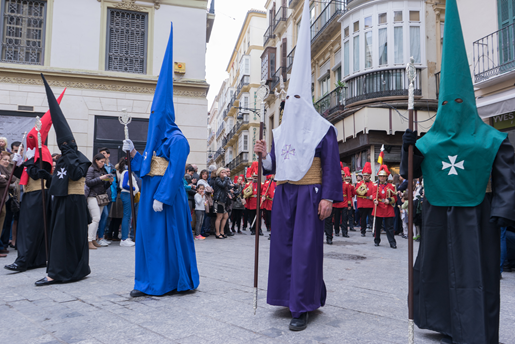
These are traditional religious garments that are still worn today, so it’s easy to see where the devs might’ve been influenced by this, and yes this was a thing before racists co-opted the garb
While the imagery and mechanics of the game heavily suggest that it’s going to be an indictment of the Catholic Church and might have something to say regarding the type of zealotry that destroys lives and leads to massive oppression, the progression of the plot and the presentation of the themes make the imagery feel just as that, imagery. There is something to be said in the way that the concepts of sin, regret, guilt, etc. all literally make up the fabric of this world, but these concepts aren’t owned by the Holy See. There’s nothing that particularly MAKES these ideas Catholic, and the game doesn’t have much else to present thematically.
It’s sort of like this shop I found one time in the Roman neighborhoods around Vatican City that was just selling priestly vestments. I don’t remember the name of it, but I’m pretty sure I referred to it as “Crazy Carlo’s Vestments and Gelato” because while it wasn’t selling gelato, it was kind of surreal to see that these ceremonial garbs that had been worn in various forms over centuries were just kind of on sale. It was literally window dressing, and while it’s not the exact sense of surreality present in BLASPHEMOUS, that is essentially how the Catholic themes are presented in the game: window-dressing.
Again, as someone who literally had this thought several times growing up, there’s a very strong sense of “I’ll go to Early Religious Education classes, but there’s no way I’ll actually learn anything.” While researching this article, I took the opportunity to speak with Kari Reichert, a former religious classmate of mine who also happens to have a degree in history, and after discussing the ins and outs of the game, she happens to agree with this sentiment. So while reading the names of these items and the lore behind them is incredibly metal, there’s nothing lost by not googling the death of St. Sebastian to understand the fate of the character Gemino.
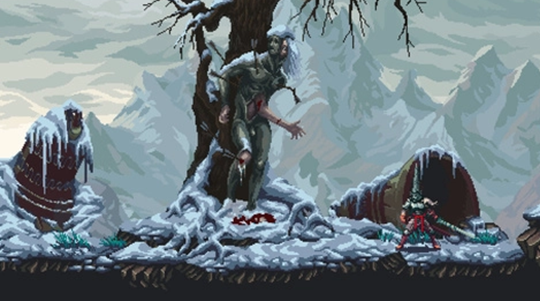
This is a great time to realize how much the game actually pays attention to what you’re doing
None of this is to say that BLASPHEMOUS is a bad game or the devs are in over their head regarding the themes or don’t know what they’re talking about. I found myself hooked by the need to explore the world and grab the next collectible spurred on by curiosity to piece together the lore. So while the use and integration of Catholic iconography isn’t exactly used to say anything other than “please stop making me feel like shit all the time,” it still functions as much-needed context for the events and themes of the game. The developers’ use of local references and the legends and stories surrounding the town they grew up in does help the game world feel more alive, even if the lore and history gets choked by the intentionally open ending and introduction. From the strumming guitars in the background to the arches influenced by the Moors who would be forced out to the references toward the works of Francisco Goya, the world of BLASPHEMOUS benefits mechanically and thematically from the team’s use of such themes. Players like myself also arguably benefit, because as of now I’ve done more research into Catholicism than I ever did during my Confirmation classes.
















Comments